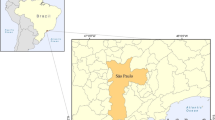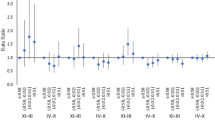Abstract
Stroke, the second cause of death and the most frequent cause of severe disability among adults in developed countries, is related to a large variety of risk factors. This paper assesses the temporal patterns in stroke episodes in a city in Northern Spain during a 12-year period and analyzes the possible effects that atmospheric pollutants and meteorological variables may have on stroke on a daily scale. Our results show that there is an increase in stroke admissions (r = 0.818, p = 0.001) especially in patients over 85 years old. On a weekly scale, the number of hospital admissions due to stroke remains stable from Monday to Friday, whereas it abruptly decreases during the weekends, reaching its minimum values on Sunday (p < 0.005); however, mortality in patients admitted to the hospital is higher on Sundays than on other days of the week. Finally, a statistically significant positive correlation between the number of stroke hospital admissions and NO2 levels (p = 0.012) and an inverse correlation with relative humidity (p = 0.032) were found. The analysis of the relationship between ischemic strokes and atmospheric circulation shows a higher frequency of the former in Santander with enhanced negative air pressure anomalies over western Spain; the fact that under these conditions the region studied registers very low values of relative humidity is in line with the aforementioned inverse correlation, which has not been described elsewhere in the literature. This study could be a first step for implementing stroke alert protocols depending on air pollution levels and circulation patterns forecasts.



Similar content being viewed by others
References
Diaz-Guzman, J., Egido, J. A., Gabriel-Sanchez, R., Barbera-Comes, G., Fuentes-Gimeno, B., & Fernandez-Perez, C. (2012). Stroke and transient ischemic attack incidence rate in Spain: The IBERICTUS study. Cerebrovascular Diseases, 34, 272–281.
Catalá-López, F., Fernández de Larrea-Baz, N., Morant-Ginestar, C., Álvarez-Martín, E., Díaz-Guzmán, J., & Gènova-Maleras, R. (2015). The national burden of cerebrovascular diseases in Spain: A population-based study using disability-adjusted life years. Medicina Clinica (Barc), 144(8), 353–359.
Abboud, H., Labreuche, J., Arauz, A., Bryer, A., Lavados, P. G., Massaro, A., et al. (2014). Demographics, socio-economic characteristics, and risk factor prevalence in patients with non-cardioembolic ischaemic stroke in low- and middle-income countries: The OPTIC registry. Global Heart, 9(1), 107–112.
Zuber, M., & Mas, J. L. (2013). Epidemiology of cerebrovascular accidents. Clínica e investigación en Arteriosclerosis, 25(5), 211–217.
Brea, A., Laclaustra, M., Martorell, E., & Pedragosa, A. (2016). Epidemiology of cerebrovascular disease in Spain. Current Opinion in Lipidology, 27(2), 187–195.
Della-Morte, D., Pacifici, F., & Rundek, T. (2016). Genetic susceptibility to cerebrovascular disease. Current Opinion in Lipidology, 27(2), 187–195. doi:10.1097/MOL.0000000000000275.
Kim, H. J., Kim, J. H., Kim, D. R., Kang, H. I., Moon, B. G., & Kim, J. S. (2014). Age and meteorological factors in the occurrence of spontaneous intracerebral hemorrhage in a metropolitan city. Journal of Cerebrovascular and Endovascular Neurosurgery, 16, 209–215. doi:10.7461/jcen.2014.16.3.209.
Palm, F., Santos, M. D., Urbanek, C., Greulich, M., Zimmer, K., Safer, A., et al. (2013). Stroke seasonality associations with subtype, etiology and laboratory results in the Ludwigshafen Stroke Study (LuSSt). European Journal of Epidemiology, 28, 373–381. doi:10.1007/s10654-013-9772-4.
Han, Myung-Hoon, Yi, Hyeong-Joong, Ko, Yong, Kim, Young-Soo, & Lee, Young-Jun. (2016). Association between hemorrhagic stroke occurrence and meteorological factors and pollutants. BMC Neurology, 16, 59. doi:10.1186/s12883-016-0579-2.
Xiang, H., Mertz, K. J., Arena, V. C., Brink, L. L., Xu, X., Bi, Y., et al. (2013). Estimation of short-term effects of air pollution on stroke hospital admissions in Wuhan. China. PLoS One. doi:10.1371/journal.pone.0061168.
Qian, Y., Zhu, M., Cai, B., Yang, Q., Kan, H., Song, G., et al. (2013). Epidemiological evidence on association between ambient air pollution and stroke mortality. Journal of Epidemiology and Community Health, 67, 635–640. doi:10.1136/jech-2012-201096.
Béjot, Y., Daubail, B., & Giroud, M. (2016). Epidemiology of stroke and transient ischemic attacks: Current knowledge and perspectives. Revue Neurologique (Paris), 172(1), 59–68. doi:10.1016/j.neurol.2015.07.013.
Cho, K. H., Park, E. C., Nam, C. M., Choi, Y., Shin, J., & Lee, S. G. (2016). Effect of weekend admission on in-hospital mortality in patients with ischemic stroke: An analysis of Korean Nationwide Claims data from 2002 to 2013. Journal of Stroke and Cerebrovascular Diseases, 25(2), 419–427. doi:10.1016/j.jstrokecerebrovasdis.2015.10.014.
Turner, M., Barber, M., Dodds, H., Dennis, M., Langhorne, P., Macleod, M. J., et al. (2016). Stroke patients admitted within normal working hours are more likely to achieve process standards and to have better outcomes. Journal of Neurology, Neurosurgery and Psychiatry, 87(2), 138–143. doi:10.1136/jnnp-2015-311273.
Mpotsaris, A., Kowoll, A., Weber, W., Kabbasch, C., Weber, A., & Behme, D. (2015). Endovascular stroke therapy at nighttime and on weekends-as fast and effective as during normal business hours? Journal of Vascular and Interventional Neurology, 8(1), 39–45.
Meng, G., Tan, Y., Fang, M., Yang, H., Liu, X., & Zhao, Y. (2015). Meteorological factors related to emergency admission of elderly stroke patients in Shanghai: Analysis with a multilayer perceptron neural network. Medical Science Monitor, 21, 3600–3607.
Warren-Gash, C., Smeeth, L., & Hayward, A. C. (2009). Influenza as a trigger for acute myocardial infarction or death from cardiovascular disease: A systematic review. The Lancet Infectious Diseases, 9, 601–610.
Vamos, E. P., Pape, U. J., Curcin, V., Harris, M. J., Valabhji, J., Majeed, A., et al. (2016). Effectiveness of the influenza vaccine in preventing admission to hospital and death in people with type 2 diabetes. CMAJ, 188(14), E342–E351.
Çevik, Y., Doğan, N. Ö., Daş, M., Ahmedali, A., Kul, S., & Bayram, H. (2015). The association between weather conditions and stroke admissions in Turkey. International Journal of Biometeorology, 59(7), 899–905. doi:10.1007/s00484-014-0890-9.
McKnight, T. L., & Hess, D. (2000) Foehn/Chinoonk Winds. In Physical geography: A landscape appreciation (p. 132). Upper Saddle River, NJ: Prentice Hall. ISBN 0-13-020263-0.
Rasilla, D. F., García-Codron, J. C., Carracedo, V., & Diego, C. (2010). Circulation patterns, wildfire risk and wildfire occurrence at continental Spain. Physics and Chemistry of the Earth, Parts A/B/C., 35(9–10), 553–560. doi:10.1016/j.pce.2009.09.003.
Vicente-Serrano, S. M., Azorin-Molina, C., Sanchez-Lorenzo, A., Morán-Tejeda, A., Lorenzo-Lacruz, J., Revuelto, J., et al. (2014). Temporal evolution of surface humidity in Spain: Recent trends and possible physical mechanisms. Climate Dynamics, 42, 2655–2674. doi:10.1007/s00382-013-1885-7.
Arboix, A. (2015). Cardiovascular risk factors for acute stroke: Risk profiles in the different subtypes of ischemic stroke. World Journal of Clinical Cases., 3(5), 418–429. doi:10.12998/wjcc.v3.i5.418.
Chen, S. Y., Lin, Y. L., Chang, W. T., Lee, C. T., & Chan, C. C. (2014). Increasing emergency room visits for stroke by elevated levels of fine particulate constituents. Science of the Total Environment, 473–474, 446–450.
Villeneuve, P. J., Chen, L., Stieb, D., & Rowe, B. H. (2006). Associations between outdoor air pollution and emergency department visits for stroke in Edmonton, Canada. European Journal of Epidemiology, 21, 689–700.
Cruz, A. M., Sarmento, S., Almeida, S. M., Silva, A. V., Alves, C., Freitas, M. C., et al. (2015). Association between atmospheric pollutants and hospital admissions in Lisbon. Environmental Science and Pollution Research International, 22, 5500–5510.
Santurtún, A., Sanchez-Lorenzo, A., Villar, A., Riancho, J. A., & Zarrabeitia, M. T. (2016). The influence of nitrogen dioxide on arrhythmias in Spain and its relationship with atmospheric circulation. Cardiovascular Toxicology. doi:10.1007/s12012-016-9359-x.
Monrad, M., Sajadieh, A., Christensen, J. S., Ketzel, M., Raaschou-Nielsen, O., Tjønneland, A., et al. (2016). Long-term exposure to traffic-related air pollution and risk of incident atrial fibrillation: A cohort study. Environmental Health Perspect. doi:10.1289/EHP392.
Querol, X., Alastuey, A., Pandolfi, M., Reche, C., Pérez, N., Minguillón, M. C., et al. (2014). 2001–2012 trends on air quality in Spain. Science of the Total Environment, 490, 957–969. doi:10.1016/j.scitotenv.2014.05.074.
Acknowledgements
We thank Dr. Rojo Roldán for his help with collecting hospital admissions data, and Alejandro Villar for his comments and input.
Author information
Authors and Affiliations
Corresponding author
Additional information
Ana Santurtún and Patricia Bolivar Ruiz have equally contributed and shared the first authorship.
Rights and permissions
About this article
Cite this article
Santurtún, A., Ruiz, P.B., López-Delgado, L. et al. Stroke: Temporal Trends and Association with Atmospheric Variables and Air Pollutants in Northern Spain. Cardiovasc Toxicol 17, 360–367 (2017). https://doi.org/10.1007/s12012-016-9395-6
Published:
Issue Date:
DOI: https://doi.org/10.1007/s12012-016-9395-6




